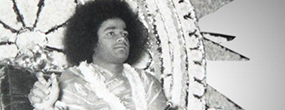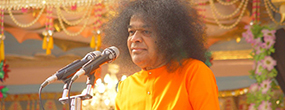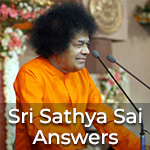The Answers to All Your Questions
Q. How should Members chant Omkar?
Repeat the ‘Om’ slowly, contemplating its vast potentialities. The ‘A’ emerges from the throat, the ‘U’ rolls over the tongue and ‘M’ ends on the lips; that is to say, ‘Om’ which is a composite of ‘A,’ ‘U’ and ‘M’ is the sum and substance of all the words that can emanate from the human tongue. It is the primordial, fundamental sound, symbolic of the Universal Absolute. After the ‘M’ there must be the unheard resonance, which represents the attributeless, formless, Abstract – the Nirakara Parabrahman. The ascending voice of the Pranava or ‘Om’ must take a curve at ‘M’ and descend as slowly as it rose, taking as much time as when it ascended, disappearing in the silence, which echoes in the inner consciousness.
- Second All India Conference, Prasanthi Nilayam | November 20-21, 1969
Q. What is the spiritual significance of Nagar Sankirtan?
Nama Smarana can be elaborated also into Nagar Sankirtan. This has both individual and social consequences. When you inhale foul air, your health suffers. The air is polluted by unwholesome vibrations when people shout hateful, lustful slogans or even talk, without love and reverence. In order to purify the atmosphere, vibrations that are holy, healthy, happy have to be circulated, even before the citizens come out into the open with the break of day. When a group of good men and women move from one end of a street to the other singing aloud the Names of God, each Name redolent with fragrance and resonant with Love, it clears the air and renders it pure for all to breathe. It also calls people living in the houses on both sides to begin their daily round of duties, with the sweet name of God in their ears and the charming form of God in their hearts.
- Third All India Conference, Prasanthi Nilayam | November 20-21, 1970
Q. How should Samitis conduct Nagar Sankirtan?
Do not start too early or too late; you must go through the streets slowly, singing aloud the Names of all manifestations, just when the people of the locality are preparing to meet the new day that is dawning. Do not carry any photo or picture with you, demonstrating your loyalty to any particular Form or Name. Walk along, in well-arranged groups, men and women separately; do not plan Nagar Sankirtan in buses, tractors, cycles or carts. Do not compete with each other in singing Namavalis and cultivate envy or hatred. Let those with a good voice and musical talent lead; the Kirtan must be pleasant. If your voice is out of tune, do not disturb the melody, but repeat the Namavali in your mind. Sing so that the full significance of each Name is evident to the hearers. Do not repeat each line more than twice; let there be time during the journey for a variety of Namavalis dealing with many Forms and manifestations of God. Do not plan to go through distances too long for the party. Maintain the sacred atmosphere from the first step to the last. Gather in a temple or some holy place, repeat the Pranava and Suprabhatam and then, move on for Nagar Sankirtan.
- Second All India Conference, Prasanthi Nilayam | November 20-21, 1969
Q. What kind of Bhajans can be sung in Samitis?
This Organisation believes that the Atma in each is the Atma in all and that the God that each worships is the God that all worship. You cannot insist that in the Bhajans only songs on Sathya Sai should be sung! Fanaticism of that kind I very much dislike and condemn. For, all names and all forms denote Me only! You betray your ignorance of My truth when you stick to any one of My names and avoid the rest. When you have identified the Atma principle and experienced its Glory, you pass beyond the realm of rules; but until then, limits and lines of conduct have to be honoured.
- Fourth All India Conference, Madras | December 22-23, 1971
Q. Which Divine Name can be used during Japa?
There are some questions among those handed over to Me, on the Name to be used in Japa, whether Ram Naam or the five-lettered Namah Shivaya or the eight-lettered Om Namo Narayana or whether I would suggest some other Name. The scriptures have given a good answer for this: God is one without a second. You can adore Him according to your own fancy and pleasure. He does not change. He is not changed, when the Names you adore Him by are changed or the Forms you picture Him by, are changed. We have many kinds of sweets – many Names and Forms. But sugar is the one substance that makes each one sweet. You may prefer one sweet thing more than another; you are welcome to prefer it, but, do not condemn or prevent others’ preferences. You may adore Krishna, for that name and form gives you the greatest joy, the maximum thrill; but, do not find fault with a brother who worships the same God through another Name-Form: Rama, Shiva or Vishnu, or any such other. He has as much right as you, to worship God in the form he likes. The effectiveness lies not in the Mantra or in the Name and Form it is centred upon. It lies in the heart, in the yearning, in the thirst. God will assume the form and answer to the Name for which you thirst! That is the measure of His Grace.
- Third All India Conference, Prasanthi Nilayam | November 20-21, 1970
Q. Can Samitis organise classes to teach Dhyana?
There is a suggestion mentioned in a chit handed over to Me by a delegate: regular classes for training members in Dhyana should be held in Prasanthi Nilayam, for through these trainees, Dhyana can be spread all over the country. I laughed when I read this suggestion. Can anyone train another in meditation? Or claim to train? It may be possible to teach a person the posture, the pose, the position of the legs, feet or hands, neck, head, or back, the style of breathing or its speed. But meditation is a function of the inner man; it involves deep subjective quiet, the emptying of the mind and filling oneself with the Light that emerges from the Divine Spark within. This is a discipline which no textbook can teach, and no class can communicate. Dhyana classes! Those who handle them do not know what Dhyana is; those who attend them do not care to know! Purify your emotions; clarify your impulses; cultivate love. Then only can you become master of yourself. That mastery is the purpose, the process of meditation or Dhyana.
- Third All India Conference, Prasanthi Nilayam | November 20-21, 1970
Q. What is the best method to practice Dhyana?
The mind must be allotted some heavy piece of work to hold it down. This work is called Dhyana. Keep the mind above the upper lip, between the two nostrils, right in front of the bridge of the nose. Inhale through the left nostril, closing the fist with the right thumb. As the breath goes in, it utters ‘So’ (meaning, He); then exhale through the right nostril, closing the left nostril. As the breath goes out, it utters ‘Ham’ (meaning, I). Inhale and exhale slowly and deliberately, conscious of the identity of He (the Lord), and I (yourself) which it asserts, until the breathing and the awareness grow into an unnoticed process. Keep the mind as a watchman, to note the incoming and outgoing breaths, to listen with the inner ear to the Soham that the breath whispers, and to witness the assertion of your being the Divine, which is the core of the Universe. This is the Dhyanam that will give victory.
When this Soham Dhyana has stabilised itself, you may start stabilising in your mind the Rupa (form) of your Ishta Devata (the Lord of your choice). Picture the Form from head to foot, taking at least 15 to 20 minutes for it, dwelling on each part of the body and imprinting it clearly on the heart and then, proceed from foot to head in similar way. This will help to fix the form in the altar of the heart. Then, you will see in everyone that Form only; in all beings, you will find Him only. You will realise the One manifold as many. Shivoham, Soham, I am Shiva, I am He, Only He is.
- Third All India Conference, Prasanthi Nilayam | November 20-21, 1970
Q. What is the role of Mahila Satsangs in the Samiti?
Women have a great role to play in the moral regeneration of the people. That is the reason for the new emphasis on Mahila Satsangs. They can tell the children the epic stories of sacrifice and heroism, of saints who sought God and saw Him in Truth, Beauty and Goodness everywhere, of great men and women, who delved into the secrets of the Universe and the Law of all laws, which governs the microcosm and the macrocosm, in equal measure. Christ said, “Let children come unto Me.” They have the sense of wonder, fresh and free; they have the simple, sincere eagerness to know; they have reverence towards knowledge and power. Tell them of Rama, Krishna, Nachiketas, Dhruva, Urmila, Shuka, Hanuman, Arjuna and many others whom they can picture with admiration in their minds… I want that you should explore the possibility of expanding the work among mothers, children and youth. The Mahila Vibhag must be strengthened. In places where there are no Mahila Satsangs, try to start one, and have Bal Vikas under their guidance.
- Second All India Conference, Prasanthi Nilayam | November 20-21, 1969
Q. Can women members participate in Vedic chanting?
For this adventure, all are candidates, women as well as men. Gender is but a vesture worn by the Soul for the role of life on earth. It does not affect the life of the Spirit, which is Eternal, and on the supra-sensory plane. Man and woman have each to purify the inner consciousness so that the Divine may reveal itself in all its Glory therein. There are some crude thinkers who declare that women are not entitled to pronounce the sacred syllable Om, but that is a pernicious narrow doctrine. With one voice, these people revere the Mother, acclaiming the dictum ‘Matru Devo Bhava’, and with the other, they disgrace the Mother by denying her the fight to save herself? This is hypocrisy. The A U M of the Om, represents the Om Tat Sat principle – the “That is the Truth,” “I am the Truth,” “the Truth is One” principle.
- Third All India Conference, Prasanthi Nilayam | November 20-21, 1970






































